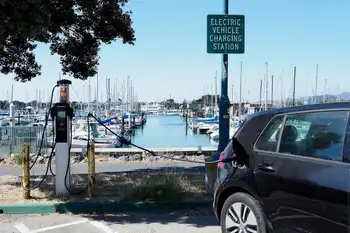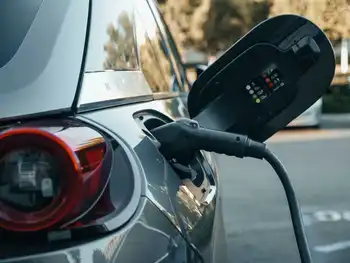CO2 output from making an electric car battery isn't equal to driving a gasoline car for 8 years

Arc Flash Training CSA Z462 - Electrical Safety Essentials
Our customized live online or in‑person group training can be delivered to your staff at your location.

- Live Online
- 6 hours Instructor-led
- Group Training Available
EV Battery Manufacturing Emissions debunk viral claims with lifecycle analysis, showing lithium-ion production CO2 depends on grid mix and is offset by zero tailpipe emissions and renewable-energy charging over typical vehicle miles.
Key Points
EV lithium-ion pack production varies by grid mix; ~1-2 years of driving, then offset by zero tailpipe emissions.
✅ Battery CO2 depends on electricity mix and factory efficiency.
✅ 75 kWh pack ~4.5-7.5 t CO2; not equal to 8 years of driving.
✅ Lifecycle analysis: EVs cut GHG vs gas, especially with renewables.
Electric vehicles are touted as an environmentally friendly alternative to gasoline powered cars, but one Facebook post claims that the benefits are overblown, despite fact-checks of charging math to the contrary, and the vehicles are much more harmful to the planet than people assume.
A cartoon posted to Facebook on April 29, amid signs the EV era is arriving in many markets, shows a car in one panel with "diesel" written on the side and the driver thinking "I feel so dirty." In another panel, a car has "electric" written on its side with the driver thinking "I feel so clean."
However, the electric vehicle is shown connected to what appears to be a factory that’s blowing dark smoke into the air.
Below the cartoon is a caption that claims "manufacturing the battery for one electric car produces the same amount of CO2 as running a petrol car for eight years."
This isn’t a new line of criticism against electric vehicles, and reflects ongoing opinion on the EV revolution in the media. Similar Facebook posts have taken aim at the carbon dioxide produced in the manufacturing of electric cars — specifically the batteries — to make the case that zero emissions vehicles aren’t necessarily clean.
Full electric vehicles require a large lithium-ion battery to store energy and power the motor that propels the car, according to Insider. The lithium-ion battery packs in an electric car are chemically similar to the ones found in cell phones and laptops.
Because they require a mix of metals that need to be extracted and refined, lithium-ion batteries take more energy to produce than the common lead-acid batteries used in gasoline cars to help start the engine.
How much CO2 is emitted in the production depends on where the lithium-ion battery is made — or specifically, how the electricity powering the factory is generated, and national electricity profiles such as Canada's 2019 mix help illustrate regional differences — according to Zeke Hausfather, a climate scientist and director of climate and energy at the Breakthrough Institute, an environmental research think tank.
Producing a 75 kilowatt-hour battery for a Tesla Model 3, considered on the larger end of batteries for electric vehicles, would result in the emission of 4,500 kilograms of CO2 if it was made at Tesla's battery factory in Nevada. That’s the emissions equivalent to driving a gas-powered sedan for 1.4 years, at a yearly average distance of 12,000 miles, Hausfather said.
If the battery were made in Asia, manufacturing it would produce 7,500 kg of carbon dioxide, or the equivalent of driving a gasoline-powered sedan for 2.4 years — but still nowhere near the eight years claimed in the Facebook post. Hausfather said the larger emission amount in Asia can be attributed to its "higher carbon electricity mix." The continent relies more on coal for energy production, while Tesla’s Nevada factory uses some solar energy.
"More than half the emissions associated with manufacturing the battery are associated with electricity use," Hausfather said in an email to PolitiFact. "So, as the electricity grid decarbonizes, emissions associated with battery production will decline. The same is not true for sedan tailpipe emissions."
The Facebook post does not mention the electricity needs and CO2 impact of factories that build gasoline or diesel cars and their components.
Another thing the Facebook post omits is that the CO2 emitted in the production of the battery can be offset over a short time in an electric car by the lack of tailpipe emissions when it’s in operation.
The Union of Concerned Scientists found in a 2015 report that taking into account electricity sources for charging, which have become greener in all states since then, an electric vehicle ends up reducing greenhouse gas emissions by about 50% compared with a similar size gas-powered car.
A midsize vehicle completely negates the carbon dioxide its production emits by the time it travels 4,900 miles, according to the report. For full size cars, it takes 19,000 miles of driving.
The U.S. Energy Department’s Office of Energy Efficiency and Renewable Energy also looked at the life cycle of electric vehicles — which includes a car’s production, use and disposal — and concluded they produce less greenhouse gases and smog than gasoline-powered vehicles, a conclusion consistent with independent analyses from consumer and energy groups.
The agency also found drivers could further lower CO2 emissions by charging with power generated by a renewable energy source, and drivers can also save money in the long run with EV ownership.
Our ruling
A cartoon shared on Facebook claims the carbon dioxide emitted from the production of one electric car battery is the equivalent to driving a gas-powered vehicle for eight years.
The production of lithium-ion batteries for electric cars emits a significant amount of carbon dioxide, but nowhere near the level claimed in the cartoon. The emissions from battery production are equivalent to driving a gasoline car for one or two years, depending on where it’s produced, and those emissions are effectively offset over time by the lack of tailpipe emissions when the car is on the road.
We rate this claim Mostly False.















